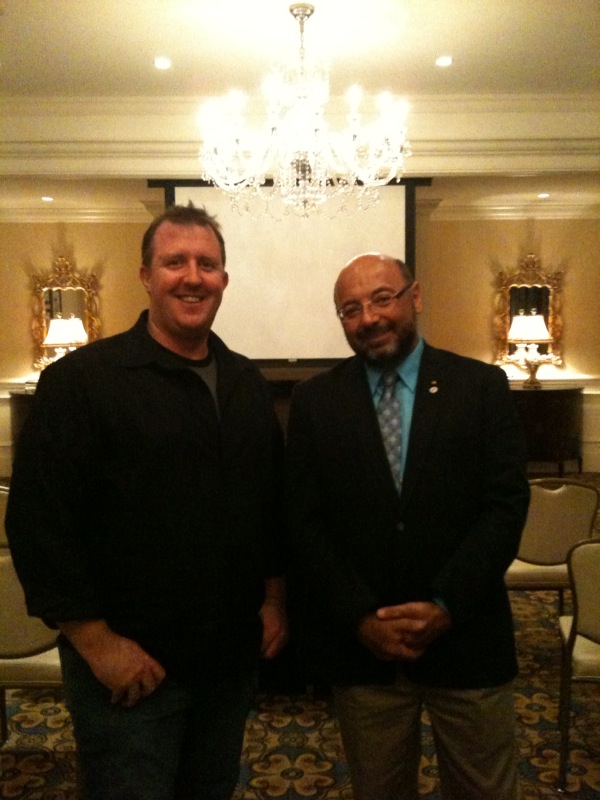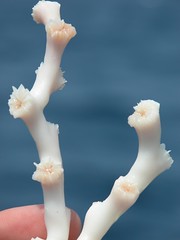 Me and David (right) at the Capital City ClubI had the very good fortune on Thursday to see a talk by David Gallo from Woods Hole Oceanographic Institution, which he delivered to the Atlanta chapter of the Explorers Club. David, who is Director of Special Projects for WHOI and a prominent speaker on TED.com, mixed it up between general ocean wonders and some stuff about Titanic. He opened his talk with a lot of the stuff in that TED link, but the Titanic stuff was all new because he had just returned from a research cruise where they mapped the entire debris field in unprecedented detail using ROVs and AUVs.
Me and David (right) at the Capital City ClubI had the very good fortune on Thursday to see a talk by David Gallo from Woods Hole Oceanographic Institution, which he delivered to the Atlanta chapter of the Explorers Club. David, who is Director of Special Projects for WHOI and a prominent speaker on TED.com, mixed it up between general ocean wonders and some stuff about Titanic. He opened his talk with a lot of the stuff in that TED link, but the Titanic stuff was all new because he had just returned from a research cruise where they mapped the entire debris field in unprecedented detail using ROVs and AUVs.
 Not the RMS Titanic, but a good example of the side-scan sonar effect. In this case the sound is coming from the upper right, creating sound shadows to the lower left. Image: NOAASide-scan sonar featured prominently in the survey work, which makes for really cool imaging. Side-scan is an increasingly popular technique that uses sonar signal deployed at an angle to generate images with a sort of bas-relief effect. This is in contrast to regular sonar which pings vertically and reconstructs a sort of plan view of the area in question. A lot of the sonar data was pretty raw, but rather than make it hard to interpret, it actually added a layer of excitment; as I understand it we were among the first folks to see any of those data.
Not the RMS Titanic, but a good example of the side-scan sonar effect. In this case the sound is coming from the upper right, creating sound shadows to the lower left. Image: NOAASide-scan sonar featured prominently in the survey work, which makes for really cool imaging. Side-scan is an increasingly popular technique that uses sonar signal deployed at an angle to generate images with a sort of bas-relief effect. This is in contrast to regular sonar which pings vertically and reconstructs a sort of plan view of the area in question. A lot of the sonar data was pretty raw, but rather than make it hard to interpret, it actually added a layer of excitment; as I understand it we were among the first folks to see any of those data.
They also took down 3D and HD cameras and filmed/photographed every square inch of the visible parts of the bow and stern sections, which lie some three quarters of a mile apart and 2.5 miles down in the icy waters off Newfoundland. We were treated to snippets of that footage, which shows undeniable deterioration of the wreck, including the mysterious disappearance of the crows nest, distortion of windows, disappearance of walls and a huge profusion of “rusticles” (like icicles made of rust) on the bow section. Estimates of the complete disintegration of the wreck range from 20 to 200 years, but there seems little doubt that the unsinkable ship will be mostly gone in our life-spans, which was one motivation for the painstaking documentation; they plan to develop a sort of “virtual Titanic” to be made available so that the public can explore her too.
Gallo closed his talk with a section on their next big project, which is a search for the wreckage of Air France flight 447, which crashed in the west Atlantic in June 2009. Hope remains that the flight data recorders from the crash are still intact and the consortium involved in the operation is apparently very confident that they will find the wreckage and the black boxes and bring closure to the families of the 228 victims of the crash.
 The submersible Alvin. Image: NOAAAfter the talk I asked David about recent news that China is making a big move into the world of deep sea exploration. I asked him whether the deep sea and China would be to the next decade what space and Russia were to the 60’s. He replied that if you want to view it that way, then the US is already well behind. He confirmed that the Chinese government has made a huge investment, as has South Korea, and he added that its kind of crazy that the US still relies so heavily on Alvin, a submersible that - while capable - is very old (commissioned in 1964!) and certainly far from the cutting edge in deep sea technologies.
The submersible Alvin. Image: NOAAAfter the talk I asked David about recent news that China is making a big move into the world of deep sea exploration. I asked him whether the deep sea and China would be to the next decade what space and Russia were to the 60’s. He replied that if you want to view it that way, then the US is already well behind. He confirmed that the Chinese government has made a huge investment, as has South Korea, and he added that its kind of crazy that the US still relies so heavily on Alvin, a submersible that - while capable - is very old (commissioned in 1964!) and certainly far from the cutting edge in deep sea technologies.
It was a terrific talk and I was very excited to have the chance to finally meet David. I teach every year in Woods Hole, but our paths have never crossed there. We made an agreement to share a beer at the Captain Kidd next time I am up there for AQUAVET, and that is something to look forward to.
 Tuesday, November 9, 2010 at 11:56AM
Tuesday, November 9, 2010 at 11:56AM  Lophelia, a deep sea coral.Fun news from colleague Andrew Shepard at Harbo Branch (Florida Atlantic U.), via Kim Morris-Zarneke:
Lophelia, a deep sea coral.Fun news from colleague Andrew Shepard at Harbo Branch (Florida Atlantic U.), via Kim Morris-Zarneke:



